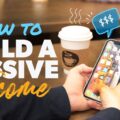It’s the perfect time to get started on your e-commerce business. With more people switching to online shopping every day, U.S. online sales are 76% higher than they were last June. That means it’s the best time for you to get online and finally start your journey as an entrepreneur.

That said, there are a number of steps to starting a dropshipping business. Like any other business venture, it takes time and effort. You need to find products, build your storefront, make a business plan and start marketing.
Dropshipping makes the process way more accessible, and successful dropshippers have used dropshipping to build e-commerce stores that make hundreds of thousands of dollars in mere months.
In this guide, I’ll show you how to build your dream business using dropshipping.
Dropshipping: The Basics
Dropshipping is a newer business model that streamlines the e-commerce process for both consumers and business owners. Unlike traditional online stores, which order products from suppliers and keep them on hand in the form of inventory, dropshipping allows the supplier to ship items directly to the customer.
This makes it one of the best ways to make money from home — especially within the e-commerce realm.
For you, the business owner, this model eliminates the overhead of ordering products in advance. It also alleviates the logistical challenges of receiving, managing and holding inventory.
For your customers, it turns those savings into lower prices so they can get quality products at fantastic deals.

Dropshipping is the perfect way to start your new e-commerce business. It’s less expensive and less risky than traditional business models, and it has the potential for both longevity and significant profit.
So, how do you start a dropshipping business?
By the end of this step-by-step guide, you’ll have a great overview of:
- How to decide on a niche.
- How to find the perfect products for dropshipping.
- How to brand your dropshipping store.
- How to build your website.
- How to market your store.
Editor’s Note: In addition to your own website, you can leverage the dropshipping business model on e-commerce platforms like ebay, Amazon, and even Walmart’s third-party seller marketplace.
Choosing A Niche
The first thing you need to do is choose a niche. In other words, you need to decide what you’re selling and who you’re selling it to. The niche is the first and most pivotal aspect of your new online business, so make sure you take your time on it.
If you don’t decide what you’re selling early on, you may end up with a store that’s hard too market. Or you may end up going head-to-head with larger retailers, which will make your business suffer as you’ll face stiffer competition and thus end up spending a lot of money on marketing efforts.
By narrowing down the type of dropshipping products you sell, you’re cutting out your own little piece of the internet pie. And this makes it much easier to turn a profit.
But how do you decide on a niche?
First of all, you should write down what you’re personally interested in.
Is there a store out there that caters directly to you?
Can you think of a store you could make where you’d be passionate about the products?
If you’re having a little trouble, there’s a quick way to speed up this process: when you’re thinking of a niche, try making a buyer persona from the following:
- Price point (e.g., discount, luxury, etc.).
- Customers (e.g., age or income level).
- Location (e.g., country).
- Interests (e.g., golf).
- Values (e.g., eco-friendly).
You don’t need to have all of these categories covered to make a full buyer persona, but combining a few can make excellent example niches that you can use as inspiration.

All of the ideas below are terrific starting points.
- Niche #1: Luxury Products for Younger Golfers in North America
- Niche #2: Discount Products for Eco-Friendly New Mothers
- Niche #3: Products for Nerdy Remote Workers in Small Apartments
Once you know your buyer persona, you can choose your niche and your place in it. For example, if you’re looking to sell discount products to eco-friendly new mothers, that may mean looking at eco-friendly baby clothing as a primary product.
Once you have a niche in mind, the next thing you want to do is check that your niche is something people want. An easy way to check is to use Google Trends.
Now, you’re not going to want to type in “eco-friendly products for new mothers,” but you will want to search for specific products that would fall into that niche.
For example, eco-friendly searches have been climbing over the past 12 months:

This shows us that people are looking for eco-friendly products in the United States. It’s a subject that has been climbing over the past year, which is a fantastic starting point for your store.
It’s also important to note that the searches are steady, so this is not a fad that will sputter out.
Successful dropshippers are adamant that choosing a niche they love makes all the difference, so you should do the same. You’ll have the upper hand because you’ll be in the niche yourself, and you’ll intuitively know what people like you want to buy.
Once you’ve decided on a niche, it’s time to move on to the next step: actually starting your dropshipping business and figuring out how to choose and source your products.
This is the point where most dropshippers fail.
How To Find Dropshipping Products
Now that you’ve identified your niche, it’s time to find some products that fit in that niche to fill your store.
Using A Niche Scraper
Having a competitive dropshipping store means having competitive products in an ever-changing environment. Fortunately, there are free tools that you can use that have done the research for you. These tools will give you real insights and data into products that have high potential.
A niche scraper is a fantastic tool for helping you find trending products and staying on top of consumer purchasing and habits.
Finding dropshipping products can be hard. Finding winning dropshipping products that are a hit amongst your market can be even harder.
Choosing a dropshipping platform that has pre-vetted dropshipping suppliers from the USA (as well as around the world), and which has automated the process, is an easier and more effective way to start your dropshipping business.
Keep in mind that fast shipping and high-quality products are the way to build a successful dropshipping business.
Throughout this article, I’ll be using Spocket as an example. Spocket helps dropshippers find products and fulfill orders. You can learn more about the company and the services they provide here.
And full disclosure: In a good old fashioned guest post swap between Spocket and The Ways To Wealth — i.e., no money was exchanged — Spocket hired me to write this post.
Begin by searching for one of the “interests” that would fall under your product niche.
For example, for products for Nerdy Remote Workers in Small Apartments, I would look for search terms like “nerd” or “gamer.”
Once we know the term we’re using, we can narrow it down with filters.

When looking at those products, there are a few critical things to pay attention to.
Product Price

The price is important because it allows you to gauge how much you can anticipate in profit. With dropshipping, you want to aim for a 30% profit margin.
Although items from the U.S. have fast shipping, sometimes they’re on the more expensive side. But don’t let that discourage you. Studies show that people are willing to pay more for high quality and faster shipping.
So use that to your advantage!
Shipping Time And Locations
This tells you how long it’s going to take Spocket’s supplier to ship a product to your customers. It also tells you where the supplier does and does not ship to. In this case, the example product above only ships to the United States.
That’s not necessarily a bad thing: the U.S. consumer market is one of the largest in the world. So having U.S.-based products on your store can offer a competitive advantage, as many dropshipping platforms only make international products available to their customers.
Product Images
Until you order product samples, the Spocket listing photos are the only pictures you can use to sell the product on your store. So high-quality images are a huge plus!
High quality photos are important because they tell your customers a visual story about the product, helping them envision it in their home or life.
If the perfect product for your store doesn’t have the best product photos, that’s OK! It just means that you should consider ordering a sample of the product and take fantastic photos yourself.
Once you’ve found the right products for your store, it’s time to import them into your online platform and move on to the next step.
Branding Your Dropshipping Store
Branding is an essential part of building your dropshipping business and establishing trust with consumers. It’s what keeps customers returning again and again, and it’s what helps people talk about your store online.
A good brand is the difference between “I got it at some store online” and “I got it on this cool website, let me show you.”
Branding is a complicated beast, with even established companies continually working to improve their brand image. When you’re starting a dropshipping business, there are four main points you can focus on:
- Name
- Logo
- Colors
- Language
If you focus on these four things, you’ll have a fantastic starting point to build your store and brand off of.
Name
A store’s name is an integral part of its identity. The main thing you want to make sure of is that your store’s name is memorable and isn’t easy to mistake for another brand.
You also want to make it related to the products you’re selling. For example, something like Shopdealz.io isn’t going to make your customers think of eco-friendly baby clothing.
Additionally, you’re going to want to make sure that the domain for your store name is available. If you snap up the .com address for a name, that’s a fantastic start. You can also use a name generator to help you cure writer’s block and give you some ideas.
Logo
Your dropshipping business’ logo should be something tailor-made to you. If you’re selling eco-friendly baby clothing, your logo will help people immediately determine whether your aesthetic is cutesy or classy. It’s the first impression that a new customer has of your store.
I suggest taking a look at similar businesses to figure out the general idea of how you want your logo to look. Once you’ve done that, you can use a free service like Shopify’s Logo Maker to get ideas for your logo.
If you find the perfect logo on a free logo maker, use it! If you don’t, that’s alright. There are fantastic graphic designers all over the internet happy to make you the perfect logo.
Colors
When you’re developing your brand, it’s good to have three main colors: your main brand color and two accent colors you can use in graphics.
These three colors should complement each other, so I’d suggest using a service like coolors.co to figure out what three colors you want to use.
Once you’ve found the three colors you like, make sure to write down the hex codes for the colors so you always have the same tone.
Language
Language is as essential to your brand as your logo. Language determines how you talk to your customers, how you write your product descriptions, and so much more.
A quick example of language would be a hiking and outdoors brand focusing on words like “exploration,” calling their customers “adventurers,” and referring to products as “rugged and durable” instead of “high quality.”
Work on your language and, most importantly, keep it consistent.
Building Your Website
Now that you’ve decided how your brand looks, as well as the products you’ll be selling, you need to build a website that sells your products efficiently.
Website Design
On your homepage, you’re going to want to avoid having too much content for your customers to scroll through. The main things your homepage should have are a hero Image, a featured collection that shows products, a banner that advertises a single collection, and a list of all your collections.
Beyond that, you can provide a little more information, but the people aren’t on your site to browse — they are on your site to buy.
According to a study by researchers at the University of Missouri, the average user spends less than six seconds reading a website’s written content. So having too much of it on your homepage is wasted space that should be helping the customer get to where they need to go.
On the same note, most people form their opinion about a website in less than a second, so bright and high-quality images are essential for success.
A fantastic baseline for your store design is to follow the rule of thirds, which is a design concept that helps evenly space content over the site (so you aren’t cluttering the website visually).
In the rule of thirds, the website is divided into a 3X3 grid, and content should be evenly split between the three horizontal or vertical rows.
Take the Spocket homepage, for example: it has the menu, content and image slider in different vertical thirds:

This way, the website can have a clean design that’s attractive to your customers and looks like it was designed by a professional (even if it wasn’t).
Extra Tools
Extra tools like pop-up banners and email marketing promotions are a fantastic way to increase your store’s conversion rate.

Keep in mind, if someone signs up for your email list, they are likely to come back to the site in the future — even if they don’t buy today.
Tools like Privy are fantastic for doing this, as well as easy to use and completely free.
You can make a pop-up with Privy in just a couple of minutes to make sure that you have the best converting site you can!
Product Descriptions
Most of the products you import from Spocket come with professional product descriptions that are fantastic starting points for selling the product.
That said, you’re going to want to change some aspects of the product description to match your store’s branding — keeping in mind what we said about the importance of language.
If you make sure that all of your product descriptions match one another, you will have a unified and professional store that builds customer confidence.
When you’re writing your own product descriptions, it’s also important to keep an eye on your keyword targets and make sure you’re using the keywords that are going to make your product show up on search engines.
Marketing Your Store
Once you have a store that’s worth looking at, the next step to starting a dropshipping business is getting people to your website. The two main ways of doing this are content marketing and traditional marketing.
Content Marketing
Content marketing is the practice of having social media pages, blog posts and more to get eyes onto you and your brand.
The easiest way to get started with content marketing is to have an Instagram account for your business that shares content relevant to your niche.
For example, if you’re selling eco-friendly clothing to new mothers, sharing baby pictures and news related to eco-friendly clothing would be a good way to start.
A blog and other social media pages would be a huge help as well. The key is to increase your online presence and provide truly valuable content that builds trust within your target community.
Once you have content that people are looking at, you can use it to introduce them to your brand, and point them directly to your store through the content you create.
Traditional Marketing
In the context of a dropshipping business, traditional marketing means paying for Facebook ads to promote your store to people who aren’t already following your social media accounts. It costs a bit of money, but you can make good ads by keeping your specific niche in mind and turning it into a buyer persona, so Facebook knows specifically who should be seeing your ad.
An important note about ads is that they should directly point to a specific product in your store. If potential customers like a product enough to click on its advertisement, you want to have them as close to the “add to cart” button as possible.
The last thing you want is a customer who wanted to buy but couldn’t find the product on your website.
Throw in a limited time sale and you’ve got yourself a high-converting dropshipping website.
Conclusion
Now that you have an idea, products, a brand, a website and a marketing, you’ve built a business that’s ready to leverage the dropshipping model!
Building a business — whether that’s an e-commerce website or a brick and mortar store — is a constant process. You’re always going to be promoting your business and improving it, so make sure to always stay on top of product trends and consumer behavior.
Continue to check our website for more articles of this kind. And, please use our comment section as well, we would love to hear from you









Leave a Reply